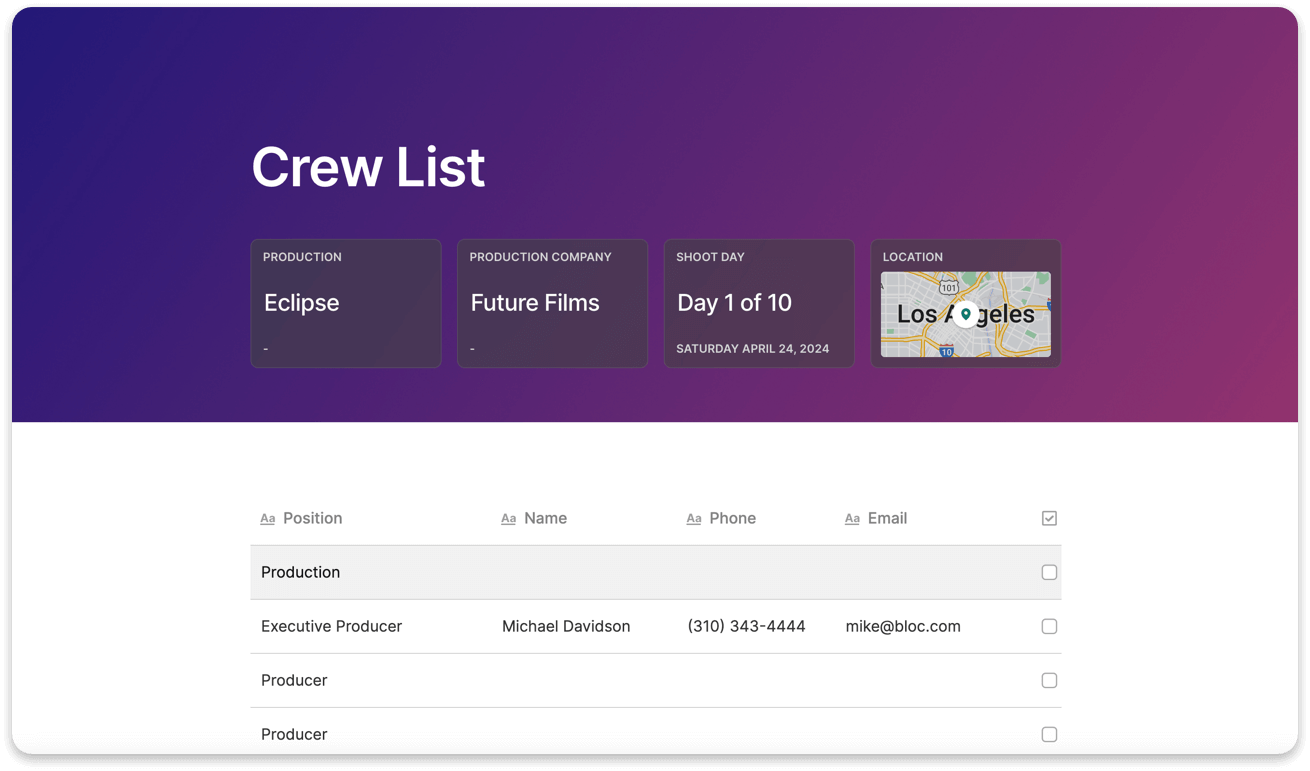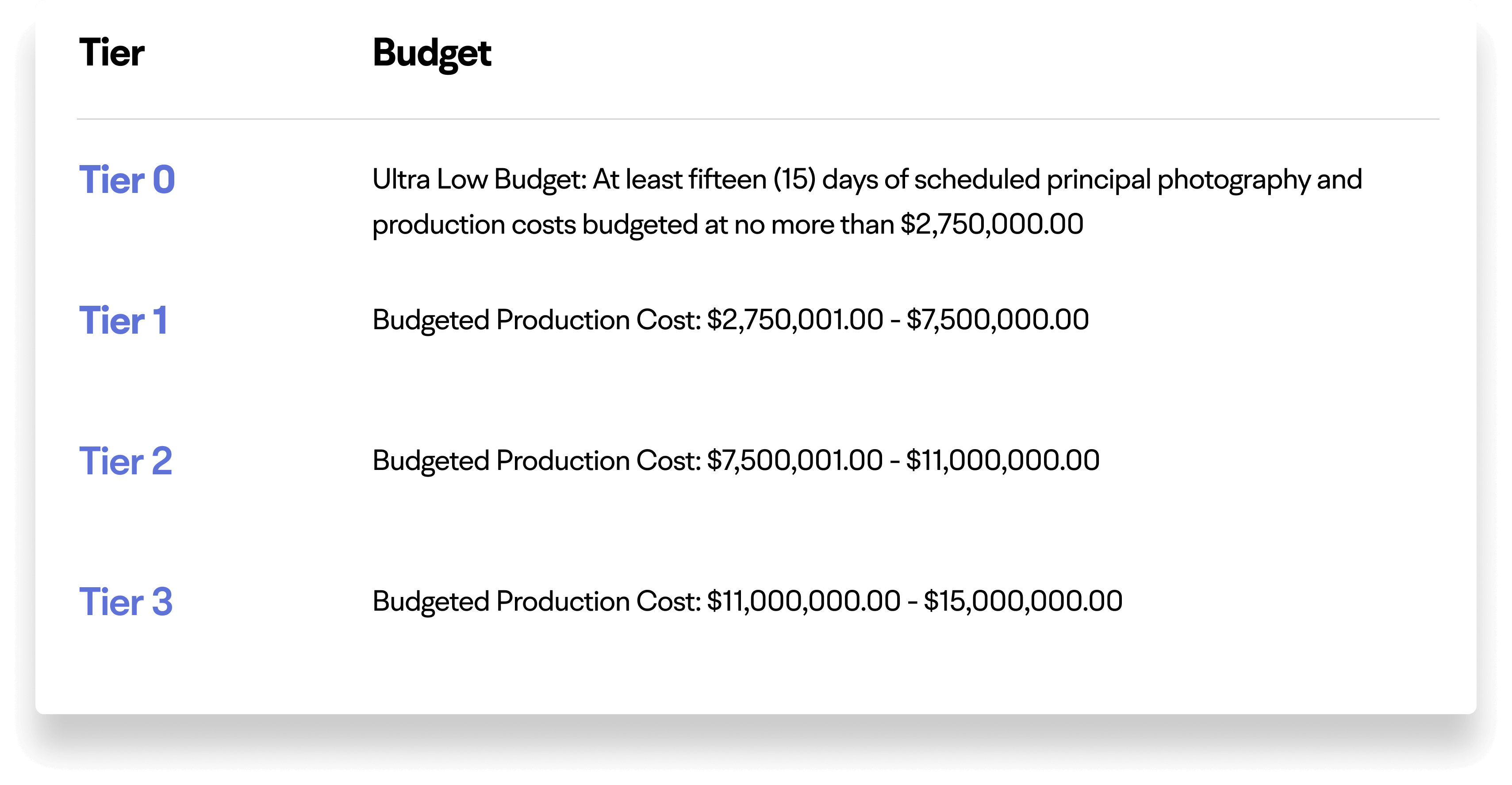“If you think it's expensive to hire a professional to do the job, wait until you hire an amateur”. Firefighter Red Adair wasn’t referring to the film industry, but he could have. Hiring a professional film crew is often key to a successful production, but balancing resources can be challenging.
In this article, we'll explore the day rates for film crew 2023 as set by the film crew unions, the tier system that establishes their minimum pay, and the difference between production and non-production cities.
Day Rates For Film Crew 2023: What You Need to Know
To calculate a crew member’s day rate, there are four considerations to take into account, which we’ll cover in this article:
- Is the crew member union or non-union?
- What tier does the budget fall under?
- Is the production filming in a ‘Production City’?
- What is the length of the shoot day?

Film Crew List Template
Use our film crew list template to track the crew for your upcoming production.
Get Template
Film Crew Unions
The first thing to determine with any film or video project is if it is signatory to a union or is a non-union production. The union has negotiated minimum rates for its members. If the production is not affiliated with a union, then using standard union rates can be a good guide to determine your worth, even if it is not guaranteed that you will be paid commercial rates.
There are several unions that oversee the interests of the film industry crew.
- IATSE (International Alliance of Theatrical Stage Employees)
- DGA (Directors Guild of America)
- Teamsters
The International Alliance of Theatrical Stage Employees represents workers in the entertainment industry. IATSE represents virtually all behind the scenes workers necessary to the functioning of the entertainment industry.
Within the U.S. and Canada, there are more than 375 IATSE local unions whose members make up the rank and file of the IATSE. The IATSE local unions are organized to represent workers by geographic and craft jurisdiction.
Each local functions independently, maintaining their own Constitution and By-Laws, elections, dues structure, membership meetings, and more. Locals negotiate labor contracts regarding wages, work rules, and grievance procedures.
Major Local Union List:
- Affiliated Property Craftspersons (Local No. 44)
- Motion Picture Studio Grips (Local No. 80)
- Affiliated Property Craftspersons (Local No. 44)
- International Cinematographers Guild (Local .600)
- IATSE Production Sound Technicians, Television Engineers, Video Assist Technicians and Studio Projectionists (Local No. 695)
- Motion Picture Editors Guild (Local No.700)
- Motion Picture Costumers (Local .705)
- Make-Up Artists and Hair Stylists (Local No.706)
- Studio Electrical Lighting Technicians (Local No. 728)
- Motion Picture Set Painters and Sign Writers (Local No. 729)
- Art Directors Guild (Local No. 800)
- The Animation Guild (Local No. 839)
- Script Supervisors/Continuity, Coordinators, Accountants & Allied Production Specialists Guild (Local No. 871)
- Motion Picture Studio Teachers and Welfare Workers (Local No. 884)
- Costume Designers Guild (Local No. 892)
The Tier System
For the union film crew, day rates can be broken down into high budget productions and low budget productions. Within the low budget productions, there are tiers of payment.
This allows the union to distinguish between low, lower, lowest and ultra low budget union films.
IASTE developed this system to allow producers to regulate wages and adjust them based on project type and the overall budget of the film. Using this system, lower budget films can set the rates based on budget limitations without exploiting the workers compensation.
The tiers are determined by the following budget ranges:
Calculating Film Crew Rates

Production vs. Non-Production Cities
Within the 3 Tiers (not including the Ultra Low Budget), there is a divide between “production cities” and “non-production cities”. This determines the amount of money that is paid to the crew, with the cities that see less production receiving a slightly lower hourly and day rate.
Production cities are:
- Los Angeles
- New York
- Chicago
- San Francisco
- Cleveland
- Detroit
- Orlando
- St. Louis
- Washington, D.C.
Length of the Shoot Day
Day rates can differ based on the amount of hours worked in a day. Here is the breakdown of how wages are calculated on a shoot day:

If you know the length of your shoot days up front, you can calculate the day rate for each crew member using the following formulas:

Day Rates For Film Crew 2023 Tier Chart
With “Ultra Low Budget Film”, one with at least fifteen days of scheduled principal photography whose production costs do not exceed a budget of two million and seven- hundred fifty thousand dollars ($2,750,000), the wage rates for covered employees are negotiated with the employee provided however the rates are not less than one-hundred twenty-five percent (125%) of the applicable state statutory minimum wage and overtime shall be computed and paid in compliance with applicable state legislation.
IATSE Rate Sheet 2023
Here is the current Low Budget Theatrical Agreement broken down by hourly day rates for film crew 2023: (any rate “subject to Negotiation” or “STN” shall be greater than any key rate, meaning department heads or key employees).
|
CLASSIFICATION |
TIER ONE |
TIER TWO
|
TIER THREE
|
||||
|
Director of Photography |
STN |
|
|
||||
|
Camera Operator |
STN |
|
|
||||
|
Digital Imaging Technician |
STN |
|
|
||||
|
1st Assistant Camera |
KEY/ $29.57 |
|
|
||||
|
2nd Assistant Camera |
2ND/ $26.72 |
|
|
||||
|
Still Photographer |
STN |
|
|
||||
|
Film Loader |
3RD/ $23.84 |
|
|
||||
|
Camera Utility |
KEY/ $29.57 |
|
|
||||
|
Digital Utility |
3RD/ $23.84 |
|
|
||||
|
Publicist |
KEY/ $29.57 |
|
|
||||
|
Key Grip |
KEY/ $29.57 |
|
|
||||
|
Best Boy Grip |
2ND/ $26.72 |
|
|
||||
|
Company Grip |
3RD/ $23.84 |
|
|
||||
|
Dolly Grip |
2ND/ $26.72 |
|
|
||||
|
Chief Lighting Technician |
KEY/ $29.57 |
|
|
||||
|
Lighting Programmer |
2ND/ $26.72 |
|
|
||||
|
Lighting Technician |
3RD/ $23.84 |
|
|
||||
|
Rigging Gaffer |
KEY/ $29.57 |
|
|
||||
|
Art Director |
STN |
|
|
|
Production Designer |
STN |
|
|
||||
|
Lead Person |
KEY/ $29.57 |
|
|
||||
|
On Set Dresser |
2ND/ $26.72 |
|
|
||||
|
Swing Gang |
3RD/ $23.84 |
|
|
||||
|
Lead/Production Painter |
KEY/ $29.57 |
|
|
||||
|
Set Painter |
3RD/ $23.84 |
|
|
||||
|
Set Designer |
KEY/ $29.57 |
|
|
||||
|
Scenic Artist |
STN |
|
|
||||
|
Construction Coordinator |
STN |
|
|
||||
|
Propmaker Foreman |
KEY/ $29.57 |
|
|
||||
|
Propmaker |
3RD/ $23.84 |
|
|
||||
|
Special Effects Foreman |
STN |
|
|
||||
|
Assistant Special Effects |
STN |
|
|
||||
|
Set Decorator |
STN |
|
|
||||
|
Key Greens |
2ND/ $26.72 |
|
|
||||
|
Marine Coordinator |
STN |
|
|
||||
|
Boat Handlers |
STN |
|
|
||||
|
On Set Picture Cars & Boats |
STN |
|
|
||||
|
Costume Designer |
STN |
|
|
|
Key Costume |
KEY/ $29.57 |
|
|
||||
|
First Set Costume |
2ND/ $26.72 |
|
|
||||
|
Custom Made Costumer |
2ND/ $26.72 |
|
|
||||
|
Costumer |
3RD/ $23.84 |
|
|
||||
|
Head Makeup Artist |
KEY/ $29.57 |
|
|
||||
|
Makeup Artist |
2ND/ $26.72 |
|
|
||||
|
Head Hair Stylist |
KEY/ $29.57 |
|
|
||||
|
Hair Stylist |
2ND/ $26.72 |
|
|
||||
|
Sound Mixer |
STN |
|
|
||||
|
Re-Recording Mixer |
STN |
|
|
||||
|
Microphone Boom Operator |
2ND/ $26.72 |
|
|
||||
|
Utility Sound Technician |
3RD/ $23.84 |
|
|
||||
|
Video Assist (Record) |
KEY/ $29.57 |
|
|
||||
|
Script Supervisor |
KEY/ $29.57 |
|
|
||||
|
First AId/Medic |
2ND/ $26.72 |
|
|
||||
|
Craft Services |
2ND/ $26.72 |
|
|
||||
|
Craft Utility |
3RD/ $23.84 |
|
|
||||
|
Studio Teacher/Set Teacher |
KEY/ $29.57 |
|
|
||||
|
Editor (weekly on call) |
STN |
|
|
||||
|
Sound Editor (48.6 hr/week) |
STN |
|
|
|
Music Editor *48.6 hr/week) |
STN |
|
|
||||
|
Assistant Editor (45 hr/week) |
KEY/ $29.57 |
|
|
||||
|
Apprentice Editor (40 hr/week) |
2ND/ $26.72 |
|
|
||||
|
Production Coordinator |
KEY/ $29.57 |
|
|
||||
|
Assistant Prod. Coordinator |
2ND/ $26.72 |
|
|
||||
|
Art Dept. Coordinator |
2ND/ $26.72 |
|
|
||||
|
Accountant |
KEY/ $29.57 |
|
|
||||
|
Assistant Accountant |
2ND/ $26.72 |
|
|
||||
|
Location Manager |
STN |
|
|
Directors, Assistant Directors & Unit Production Managers
The Directors Guild of America is a labor organization that represents the creative and economic rights of directors and members of the directorial team working in film, television, commercials, documentaries, news, sports and new media. In film, this includes Directors, Assistant Directors and Unit Production Managers.
Director’s Day Rate
Under a DGA contract, directors receive a minimum feature film director day rate of $4,081 to $5,441. However, this is a high level position that is negotiated depending on past quotes, experience and budget of the project. For example, Christopher Nolan was reportedly paid $20 million upfront and 20 percent of the gross for Dunkirk. That’s quite a range from the DGA high budget minimum.
Director High Budget Minimum Chart
|
Current Rate |
HIGH BUDGET |
SHORT & DOCUMENTARIES |
|
Weekly Salary |
$21,765 |
$15,544 |
|
Guaranteed Preparation Period |
2 Weeks |
2 Days |
|
Guaranteed Employment Period |
10 Weeks |
1 Week + 1 Day |
|
Guaranteed Cutting Allowance |
1 Week |
0 |
|
Compensation for Days Worked Beyond Guarantee |
$4,353 |
$3,109 |
|
Daily Employment Where Permitted |
$5,441 |
$3,886 |
Theatrical Directors - Low Budget Sideletter
|
Level 1 & 2 |
On motion pictures with budgets equal to or less than $2,600,000: The Director’s initial compensation, daily rate and preparation time will be subject to negotiation between Employer and the Director. |
|
Level 3 |
On motion pictures with budgets greater than $2,600,000 but equal to or less than $3,750,000: The Director’s initial compensation shall be no less than $75,000 for a minimum guarantee of 13 weeks. The minimum compensation for a Second Unit Director is $1,500 per day. |
|
Level 4A & 4B |
On motion pictures with budgets greater than $3,750,000 but equal to or less than $8,500,000, Directors have a minimum guarantee of 13 weeks and may be paid a salary, along with 2nd Unit Directors, no less than the amount in this chart which is 75% of the applicable minimum salary in Article 3 of the BA (as follows): |
Level 4A & 4B
|
Weekly Salary @75 percent |
$16,324 |
|
Guaranteed Preparation Period |
2 Weeks |
|
Guaranteed Employment Period |
10 Weeks |
|
Guaranteed Cutting Allowance |
1 Week |
|
Compensation for Days Worked Beyond Guarantee |
$3,265 |
|
Daily Employment Where Permitted |
$4,081 |
|
Level 4C |
On motion pictures with budgets greater than $8,500,000 but equal to or less than $11,000,000, Directors have a minimum guarantee of 13 weeks and may be paid a salary, along with 2nd Unit Directors, no less than the amount in this chart which is 90% of the applicable minimum salary in Article 3 of the BA (as follows): |
Level 4C
|
Weekly Salary @90 percent |
$19,589 |
|
Guaranteed Preparation Period |
2 Weeks |
|
Guaranteed Employment Period |
10 Weeks |
|
Guaranteed Cutting Allowance |
1 Week |
|
Compensation for Days Worked Beyond Guarantee |
$3,918 |
|
Daily Employment Where Permitted |
$4,897 |
Unit Production Manager and Assistant Directors
|
CURRENT RATES |
UNIT PRODUCTION MANAGER |
FIRST ASSISTANT DIRECTOR |
KEY SECOND ASSISTANT DIRECTOR |
2ND SECOND ASSISTANT DIRECTOR |
ADDITIONAL SECOND ASSISTANT DIRECTOR |
|
Weekly Studio Salary |
$6,212 |
$5,907 |
$3,958 |
$3,736 |
$2,274 |
|
Weekly Location Salary |
$8,698 |
$8,262 |
$5,531 |
$5,225 |
$3,190 |
|
Weekly Production Fee, Studio |
$1,347 |
$1,096 |
$834 |
$0 |
$0 |
|
Weekly Production Fee, Location |
$1,604 |
$1,347 |
$1,096 |
$0 |
$0 |
|
Daily Employment Salary, Studio |
$1,553 |
$1,477 |
$990 |
$934 |
$569 |
|
Daily Employment Salary, Location |
$2,175 |
$2,065 |
$1,383 |
$1,306 |
$797 |
|
Daily Employment Production Fee Studio |
$337 |
$274 |
$209 |
$0 |
$0 |
|
Daily Employment Production Fee Location |
$401 |
$337 |
$274 |
$0 |
$0 |
Film Rates for Teamsters
The Motion Picture and Theatrical Trade Division of the Teamsters represents thousands of workers in the motion picture industry, including firms that produce feature films, television programs, commercials and live theatrical productions. The division’s Teamsters in the industry include drivers and other transportation professionals, animal wranglers, casting directors, location scouts and others. In Hollywood, the teamsters union is local 399
Here is a basic list of teamster film rates:
|
Classification |
Hourly Rate |
|
1st Production Driver Gang Boss |
$48.80 |
|
All other Gang Bosses |
$44.42 |
|
Drivers of Automobiles and Motorcycles |
$24.04 |
|
Drivers of Automobiles for Producers |
$34.03 |
|
Drivers that require a Class C license |
$36.05 |
|
Drivers that require a Class B license |
$39.34 |
|
Drivers that require a Class A license |
$42.43 |
|
Drivers of 32 passenger Vans |
$42.43 |
|
Camera Car Driver |
$48.80 |
Union Rates For Film Crew in More Detail
The following are three important unions and pay scales to know. Local 705 is the Motion Pictures Costumers Local, Local 600 is the International Cinematographers Guild (ICG) of the International Alliance of Theatrical Stage Employees (IATSE) and Local 80 represents motion picture studio grips, crafts service, set medics, marine and warehouse workers.
Local 705 Pay Scale
Local 705 is divided into Finished Costumers, Custom Made Costumers, Costume House Costumers, and Television Costumers. The Finished and Custom Made Costumers work under the Film Production Contract. There are separate contracts for the Costume Houses and the Television Costumers.
Below is the Motion Picture Costumers Local 705 pay scale chart showing their range of day rates within the IATSE tier system.
- Key Costume: $325 to $437
- First Set Costume: $293 to $395
- Custom Made Costumer: $293 to $395
- Costumer: $262 to $377
Local 600 Union Pay Scale
Local 600 is the International Cinematographers Guild (ICG) of the International Alliance of Theatrical Stage Employees (IATSE). IATSE Local 600 is also referred to as IATSE 600, ICG 600, and 600 camera union. Anyone from Cinematographers to film loaders to still photographers can join the union. Local 600 is open to anyone who supports the camera.
Below is the Local 600 Union Pay Scale Chart showing their range of day rates within the IATSE tier system. The director of photography is a negotiated position.
- Camera Operator: $570 to $630
- Digital Imaging Technician: $570 to $630
- 1st Assistant Camera / Focus Puller: $325 to $548
- 2nd Assistant Camera: $293 to $420
- Still Photographer: $570 to $630
- Film Loader: $263 to $378
- Camera Utility $325 to $437
- Digital Utility $263 to $378
Local 80 Pay Scale
Local 80 represents motion picture studio grips, crafts service, set medics, marine and warehouse workers. Here, we’ve included the most recent local 80 pay scale rate cards for studio grips and craft services.
Local 80 Grip Rates
The grip is the person in charge of setting up or rigging equipment to support the camera and lighting. They assist the cinematographer in preparing the technical aspects of capturing the image on film.
Below is the Local 80 grip rate chart showing their range of day rates within the IATSE tier system.
- Key Grip: $325 to $450
- 2nd: $294 to $407
- Dolly Grip: $294 to $422
- Grip: $263 to $390
Local 80 Craft Service Rates
Craft services, or crafty, is a film production position responsible for providing snacks and drinks to all crew members. It is different from catering, which provides hot, sit-down meals. Craft services are technically for the "crafts" -- the grips, costume department, makeup artists, camera and lighting crew -- who need to be fueled throughout the work day.
Below are the Local 80 craft service rates showing their range of day rates within the IATSE tier system.
- Key Craft Services: $294 to $407
- Assistant Craft Services: $262 to $390
Crew Rate Example Calculation
Confused yet? Utilizing the IATSE rate card for 2023 and charts provided in this article, it’s easy to determine any day crew rate.
For example, let’s say we’re hiring a Key Grip for a 10 hour day on a union shoot in New York. The budget for the film is coming in at $10,000,000.
Since a $10,000,000 budget would fall under a Tier Two budget, we’ll check the hourly rate for a key grip using the film crew tier chart. Additionally, since the film shoots in New York, we’ll reference the ‘Production Cities’ number.
Based on the chart, the Key Grip’s hourly rate should be $37.77.
Next, calculate the daily rate by referencing the day rate chart above.
$37.77 x 11 = $415.47
And there you have it. The union rate for a key grip comes in at just over $400 per day.
Non-Union Film Crew Rates 2023
When you are working on a non-union production, the only protection you have in terms of non-union film crew rates is minimum wage of applicable state law. The best way to know what is a fair wage for any department is to look at what the union has determined is the minimum amount for the budget of the production. This will give you a range of what to expect when you are negotiating your salary. To help, below are a range of day rates based on the minimum film crew union rates found in the low-budget theatrical contract.
Camera Operator Day Rate
A camera operator day rate using the IATSE tier system as a guide and an industry standard 10 hour workday would have an approximate minimum pay range of $600 to $650 . It's likely you will pay a camera operator more based on experience, production city, and higher budget.
Union Makeup Artist Day Rate
A union makeup artist day rate using the IATSE tier system as a guide and an industry standard 10 hour workday would have an approximate minimum pay range of $325 to $475. It’s important to note a kit rental is usually an additional negotiated cost. However, you may pay a union makeup artist more based on experience, production city and higher budget.
Wardrobe Stylist Rate Sheet
A wardrobe stylist rate sheet is dependent on the production and role. A costume designer is a negotiated position depending on past credits and quotes. The wardrobe stylist could be the designer on a small budget production or responsible for dressing the talent. Based on a IATSE union key costumer day rate and a 10 hour industry standard workday, a wardrobe stylist day rate might range from $325 to $400. This could be higher based on experience, budget and production city.
Gaffer Day Rate
A union gaffer day rate using the IATSE tier system as a guide and an industry standard 10 hour workday would have an approximate minimum pay range of $325 to $400 . You may pay a rigging gaffer more based on experience, production city, and higher budget.
Production Assistant Day Rate
Production assistants do not have a union, so they negotiate their own rates, which can vary widely. However, usually the day rate for a production assistant is $150 to $250 per day depending on experience and budget of the production.
Script Supervisor Day Rate
A script supervisor day rate using the IATSE tier system as a guide and an industry standard 10 hour workday would have an approximate minimum pay range of $325 to $450. It's highly likely that this very important role will be negotiated at a higher rate based on budget, experience, and production city since the minimum pay for a script supervisor is dependent on years in the industry.
Producer Day Rate
A producer’s salary is usually a negotiated flat rate or a percentage of the profits which can result in an enormous payday. Since there are many types of producers on a film, each with different responsibilities from raising money to coordinating day-to-day logistics, it is difficult to place a number on them. In commercial work, the producer day rate is typically in the $450 to $900 range, but can be much higher.
Production Designer Day Rate
A production designer's rate is determined by past credits, previous quotes, and the production's budget. As this is a negotiated rate, there isn’t a minimum to consider. However, typically a production designer day rate can be anywhere from $450 to $2,000. Keep in mind this number can be much higher depending on the scope of production.
Production Fixer Rates
Film fixers arrange interviews, location permits, transport, hotels, and location scouting for films. This is very much like a producer or production coordinator. Often, fixers work for agencies, media companies, and film productions taking place abroad where they need someone local to handle all the details. Production fixer rates vary from $700 to $1000 per day. However, keep in mind an individual's quote might be much higher depending on the type of project.
DP Day Rate / Cinematographer Day Rate
The DP (director of photography) or cinematographer is a high level position and their salary is negotiated depending on experience. An established DP can earn six figures or more on a single project. For the non-union freelancer working low-budget, the director of photography day rate or cinematographer day rate ranges between $1000 to $1800 per day. You should consider this a conservative estimate when preparing your budget. This is particularly true if you are working with union professionals who will have individual quotes and likely a much higher daily or weekly rate.
1st AC Day Rate / Focus Puller Day Rate
A 1st AC day rate or focus puller day rate using the IATSE tier system as a guide and an industry standard 10 hour workday would have an approximate minimum pay range of $325 to $550. As this is a position that works very closely with the cinematographer, it is likely you will pay a 1st AC / focus puller more based on experience, production city, and higher budget.
2nd AC Day Rate
A 2nd AC day rate using the IATSE tier system as a guide and an industry standard 10 hour workday would have an approximate minimum pay range of $320 to $420. It is likely you will pay a 2nd AC more based on experience, production city, and higher budget.
Production Coordinator Day Rate
A production coordinator day rate using the IATSE tier system as a guide and an industry standard 10 hour workday would have an approximate minimum pay range of $325 to $440 . It's likely you will pay a production coordinator more based on experience, production city, and higher budget.
Key Grip Day Rate
A key grip day rate using the IATSE tier system as a guide and an industry standard 10 hour workday would have an approximate minimum pay range of $325 to $440 . It's likely you will pay a key grip significantly more based on experience, production city, and higher budget.
Additional Thoughts for Non-Union Crew 2023
Remember that if you are a crew member that is also expected to provide your kit (such as camera, electrical, audio or grip), you should charge extra for the rental. For standard equipment rental rates comparison, you should visit several rental house websites.
If you are working in cities outside of New York or Los Angeles, you may want to research local film community websites or state film commissions for resources and comparative rates. For example, if you were seeking work in Atlanta, the Georgia Film Office has a wealth of information.
It is also valuable to know if you are living and working in a right-to-work state. A right-to-work state is a state that does not require union membership as a condition of employment. In other states, a person applying for a job where the employees are unionized could be required to join the union as a requirement of being hired. There are 28 states with right-to-work laws: Arizona, Alabama, Arkansas, Florida, Idaho, Georgia, Indiana, Kansas, Iowa, Kentucky, Michigan, Louisiana, Mississippi, Nebraska, Missouri, Nevada, North Dakota, North Carolina, Oklahoma, South Dakota, South Carolina, Tennessee, Utah, Virginia, Texas, Wisconsin, and Wyoming. West Virginia legislation is pending.
Film Crew Pay Rates Wrapping Up
Rates for film crews are always changing and often amended. Information on each local union's website is the best source of current information. Here are some helpful resources.
- There are 366 local unions across 14 districts. Utilizing the local directory will get you in contact with the appropriate union for your hiring needs.
- The Producer - IATSE AND MPTAAC (Motion Picture Technicians Artists and Allied Crafts) Basic Agreement.
- Assemble has a breakdown of SAG-AFTRA day rates and minimums.
- A handy guide for department hiring needs: film crew hierarchy chart.
- For the most up-to-date news on IATSE initiatives.

